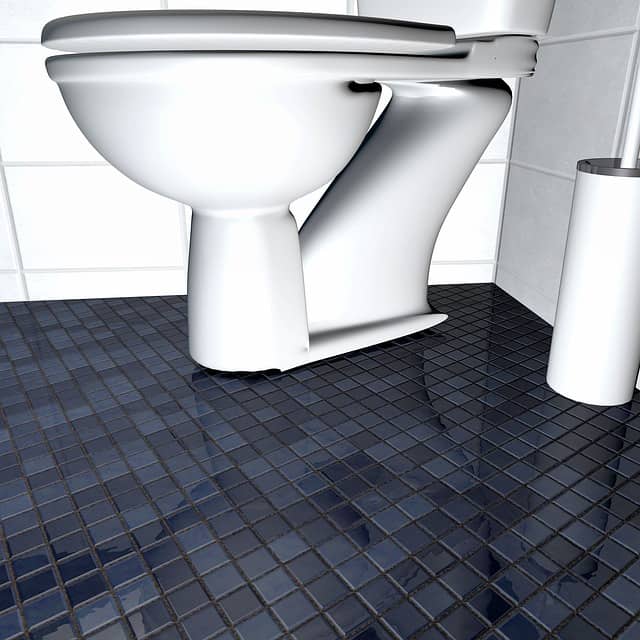One thing I learned when working as a plumber was that homeowners don’t know enough about fixing simple things like a clogged kitchen sink.
I’m glad you’re here because it means you want to learn how to fix something in your home on your own to save yourself some money.
This article is primarily about unclogging a kitchen sink drain however, most of the troubleshooting tips provided can be applied with almost any sink in your home.
There are 7 things you can use and check to identify and fix a clogged kitchen sink. Check the p- trap, check the garburator, use a plunger, use vinegar, use boiling water, use CLR or Drano, and use a drain snake.
In random order, I’ll explain what to check for and how to get your sink unclogged. Before that, let’s discuss how to recognize when your drain is about to become clogged.
If you can troubleshoot before the drain is completely clogged, it’s just much easier to fix.
How do You Know when the Drain is Plugged?
Most of the time, a clogged drain ‘creeps up’ on you. It’s not an instant thing that just happens. It’s months of putting things like grease, butter, small food particles and even dish soap down the drain that end up getting stuck somewhere.
Over time, the sink starts to drain slower and slower and because it takes so long, you might not notice what’s happening.
If you keep in mind that a typical drain empties out quickly, you should notice it slowing down.
Of course, noticing a drain slowing down and an obviously clogged drain are different. A clogged drain can literally stop all water from exiting the sink. That one is the easiest to identify.
The best thing about this task is it’s easy and the mechanics of a drain are simple so anyone can figure this out, especially with my help.
Okay, let’s get started…
1. Use a Plunger
My go-to for unclogging drains is usually a plunger. I like plungers because they add pressure to the blockage to free it up without having to use chemicals or anything else to release into the environment or damage the plumbing over time.
When using a plunger, if it doesn’t clear the clogged drain easily, you already know you have serious blockage.
There are a couple of different types of plungers – some will work better than the others. I recommend a plunger that has a flat bottom so it sits on the sink and will create a seal.
The other type that doesn’t work as well (but is worth a shot if you don’t have a flat toilet plunger) is the shaped plunger that fit directly into the bottom of your toilet. They remind me of a beehive, for some reason.
Regardless of which plunger you have, here’s how to use it to get the best results.
- Fill the clogged sink up with a few inches of water. If the sink is draining a bit, place the plunger over the sink drain to stop the water.
- Once the sink has a few inches of water, place the plunger over the drain basket, so it sits flush. Hold the plunger so there’s a tight seal.
- Start plunging straight up and down multiple times.
- Lift the plunger to see if the drain is unclogged.
- If the drain isn’t unclogging, repeat the process a few more times. Don’t give up after the first try.

If after multiple attempts the drain is not working, feel free to move on to the next steps to further trouble shoot. If the water is moving a bit better but still not 100% flowing the way it should, you can either keep plunging or try the next steps listed below.
If you need a plunger that’ll fit on a kitchen sink , tub, or other sinks, check these ones out on Amazon.
2. Checking the Garburator (Garbage Disposal)
This applies only if you have a garburator. If you have a double sink and the plugged drain is the opposite sink from the one with the garburator, you can skip this step.
If you have a single sink or the clogged drain is on the same side as your garburator, then keep reading.
The first thing to always do when dealing with anything electric is to either flip the breaker or unplug the unit. If you have a plugged-in garbage disposal, just unplug it. If yours is hard-wired, then you’ll have to turn the breaker off.
Once that’s done, you can proceed.
The first thing to do is to get a flashlight and shine it down the top opening on the unit to see if you can spot what is clogging the drain.
If you find there’s a blockage, take an Allen wrench and find the Allen nut (hole) on the underside of the unit. Once you have the right sized Allen key, start turning.
If you have resistance, keep turning until it feels like the blockage has broken up.
Next, would be to plug in and turn on the garburator. Turn on some water to help clear the unit.
You can also try resetting the unit. There’s a switch either on the side or underside of the unit. Try that and turn it on to see if it somehow magically works.
If there’s still no change, then chances are the clogged drain is just past the garburator – most likely in the p-trap, which is what we’ll go over next.
Sometimes these units stop working however, the drain function should still work. If you’re getting a humming or buzzing sound when you turn it on, it could be the unit needs to be replaced. Try the above methods and if that doesn’t work, you should probably replace it.
3. Check the P-Trap
The p-trap is the elbow or s-looking fitting where the sinks drain drops vertically, then loops up and then horizontally connecting to a pipe that runs into the wall. The p-trap is there to stop sewer gases and odors from coming up from the sewer. Water sits in the p-trap to prevent the gases from coming back up through the sink.
Most p-traps have a union nut on them so they can be taken apart for this specific reason.
Here’s what to do.
- Get a small pail to place under the p-trap.
- Use your hands or a large adjustable wrench to turn the union nut counter clockwise. Hold the underside (bottom) of the p-trap while loosening the nut.
- As you loosen, the nut water should start to run out. You can catch that with the pail.
- Loosen the nut right off and visually check for blockage on the sink side and sewer side (both sides) of the p-trap.
- Once you have identified the blockage and cleared it away, you can tighten up the nut. Hand tight is usually good enough. There’s no real water pressure there, so you don’t have to over tighten.

If you don’t see any blockage, try running a bit of water into the sink. If the water runs out, you know the blockage is on the other side (sewer side) of the drain. If it doesn’t, you know it’s on the sink side of the drain. Either way, you should be able to dig it out.
You might need a sink drain snake. I have a section below on using one.
4. Try a Plumbing Drain Snake
A plumbing snake is like a toilet snake in how it works but quite a bit narrower than a traditional toilet snake. I highly recommend if you own a home that you have a drain snake in your toolbox.
There are a couple types of snakes for drains and either is okay. Some are made of a non-break nylon and others are carbon steel. The carbon steel types are mini versions of a toilet snake.
Both can help you clear blockage and if they can’t do the job, they can be used to measure how far down the line the problem exists.
- The first and simplest style to use is a nylon type where the length of the snake has burs on it. The burs will help to loosen up any blockage. This style is used by inserting the end into the sink drain, forcing it down until it hits blockage then with a jabbing motion breaking up the debris.
- The second type are the carbon steel drain snakes. Most of these have a handle and a location where you can use a cordless drill to spin the coil as you push it down the drain. Some are a crank style. Either works fine.
Check out these great options for kitchen drain snakes over on Amazon.
If you don’t have a drain snake but have a wire coat hanger, you could use that instead.
5. Try Using Boiling Water
Sometimes doing something as simple as pouring boiling water down the drain can help free up any blockage, especially if the blockage is caused by grease and dish soap buildup.
Whenever I boil eggs or pasta, I always pour that water down the drain as soon as I can to help break down any build up of greases or soap.
If you have a large pot or tea kettle, try filling it up to the max and pouring it into the sink as soon as it boils.
If the hot water drains, GREAT! If not, try using your plunger or drain snake to help. Careful you don’t scold yourself.
Just an FYI that hot water from the tap is probably not hot enough.
If that didn’t work, let’s move on to some different types of liquids that might help get the job done.
6. Use Vinegar and Baking Soda
I regularly use white vinegar to clean mineral build up in my coffee maker so it makes sense that it can also help in a drain. Vinegar alone, however, might not be enough. If you add baking soda to vinegar, here’s what happens.
The two ingredients neutralize each other but, in the process, they create carbon dioxide and start foaming and bubbling. This reaction is what helps to clear clogs in drains. The bonus of using these products is they’re natural, not chemical, so you won’t hurt anything.
Here’s what I recommend doing.
- Pour 1/2 a cup of baking soda into the sinks basket strainer (drain) so it goes down the drain. It’s important to do this step first. If you poured the vinegar first, the chemical reaction would happen at the basket strainer and not near the blockage.
- Next, pour a cup of vinegar down the drain. To keep pressure on the clogged part of the pipe, put the sink plug in.
- Next, let the baking soda and vinegar sit for 15 to 30 minutes.
- When it is time to check if this worked, I’d recommend boiling some water and using that to pour down the drain.
If all worked well, your mixture of these two ingredients should have cleared up the clogged sink. If not, then move on to the next suggestion. If you had some success, try this again or one of the other recommendations above. Sometimes a couple shots of boiling water will help move the debris, if this step helped loosen things up.
7. Try Using Drano or CLR
Lastly, if all else has failed, using a commercial chemical to unclog a kitchen sink is your next option.
Following the directions on the container and wearing rubber gloves and safety eyeglasses is all you need to do.
As with any chemical drain cleaner, be careful not to spill any of it on anything other than in the sink drain.
How to Prevent Clogging a Kitchen Sink
Preventing future clogging is just creating the habit of not pouring some things down the garbage disposal or drain.
If you have a garbage disposal, try not to overload the unit. A cup or so at a time is okay but no more.
A small list of some things to avoid putting in the garburator or sink drain include:
- Chicken and other animal bones.
- Grease and oils. With bacon grease, I use a paper towel to soak it up out of the pan and throw the towel in the garbage.
- Any type of food containers or wrappers.
- Things like gum, toothpicks, silicone, caulking, paint, or other household items.
- Large chunks of hard vegetables like carrots or other food waste. I know you should be able to place them down a garbage disposal, however, consider cutting them into smaller pieces first or throwing them in a compost bin or the garbage.
- Remember, nothing bigger than a grain of rice should go down the drain!
Regular maintenance and common sense will help you going forward to keep your kitchen sink free from future clogs.
Final Thoughts
A clogged drain isn’t fun, but it isn’t that hard to diagnose the problem and fix. Just follow the different steps in this article and you should be able to free up the blockage.
If you figure out the drain is clogged further down the horizontal drainpipe, you can try and snake it with a sink snake or even a toilet snake. If you can’t clear it, you should probably call a plumber.
Thanks for reading – good luck!
Recommended Posts
Is it Safe to Clean Paint Brushes in the Kitchen Sink?



